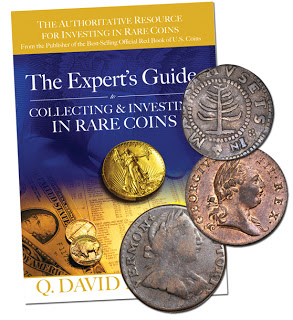
Looking for Something New to Collect?
Colonial Coins Beckon!
In The Expert’s Guide to Collecting and Investing in Rare Coins, Q. David Bowers included the following:
Getting Started with Colonial Coins
Collecting colonial coins is a captivating pursuit, and virtually everyone who takes up the pursuit is fascinated by it. Perhaps more than for any numismatic specialty, a recipe for successful collecting involves two parts of reading and investigating to one part buying. Of course, this is very enjoyable to do—and is one of the reasons that the field has so many devotees.
For starters, after you read this, spend an hour with the front section of A Guide Book of United States Coins, starting with the fine-print stuff under ‘Money of the Early Americans.’ Also review the earlier years described in chapter 10 of The Expert’s Guide to Collecting and Investing in Rare Coins. Do this, and when you are finished you will have a basic casual knowledge of what colonial and early American coins are all about.
In the strictest sense, colonials are coins produced before the Confederation and the signing of the Declaration of Independence. In popular practice, colonial coins include coins of the 1780s struck for the states, and even Washington tokens. Regarding states, officially the first state was Delaware, which ratified the United States Constitution on December 7, 1787. Accordingly, in the strictest sense, the ‘state coinages’ of Vermont, Connecticut, New Jersey, and Massachusetts, which all commenced before that time, were produced by ‘states-in-waiting.’ Vermont did not achieve statehood until 1791. If anything, such nomenclature reflects that definitions for early American issues are often casual.
If your interest in early American coins has been piqued, it is natural to get your feet wet right away—by buying some colonials. I suggest you do this. However, at the outset, limit yourself to well-struck coins in higher grades (VF or better), without flaws and with good eye appeal. A dealer specialist in colonials, or at least a professional with a good working knowledge of the series, should be your source—not the Internet and not offerings from sellers who are not knowledgeable. As to certification, it can be a mixed bag. The services attempt to assign a single grading number, but such numbers give no clues to the many other variables that affect a colonial coin’s value.
Perhaps an easy choice for you would be to buy a 1773 Virginia copper halfpenny in AU or Mint State. There are a lot of these around, and they are usually well struck. If you find one with good eye appeal, it can be bought to advantage—and will not need to be replaced or upgraded later. Once you buy, take an hour to read all about how it was made and distributed, using the Crosby and Breen texts described below. If you reallywant to have a Zen or bonding experience with your newly-acquired coin, borrow a copy of Eric P. Newman’s 1957 study, Coinage for Colonial Virginia, from the ANA Library in Colorado Springs or track one down from a seller of out-of-print numismatic books.
I do not mean to overdo the subject of focusing on the history and background of the coins you buy. I realize that many readers may simply acquire a piece and then put it into a drawer or safe deposit box. However, a coin can speak to you and tell you a lot if you let it do so. In my All About Coins class at the ANA Summer Seminars a few years ago I always suggested to my students that the coins themselves should be carefully examined and appreciated, instead of simply reviewing printed listings about their rarity and value.
There are two books you will need to buy, one being a reprint of Sylvester S. Crosby’s 1875 masterwork, Early Coins of America. This volume is still the standard source today for historical information! The content of Crosby ranges from dull (as in the recitation of laws and proclamations) to endlessly fascinating and evocative of mystery (as in the section on Vermont coppers and the curious happenings at Machin’s Mills).
The second essential book is Walter Breen’s Complete Encyclopedia of U.S. and Colonial Coins, 1988, for much in depth commentary about varieties.
If you become serious about this specialty, sign up for membership in the Colonial Coin Collectors Club (C4). Through the American Numismatic Society (New York City), subscribe to The Colonial Newsletter.
With the preceding, you will have enough to keep you busy for a month or two in reading and contemplation. If you absorb even half of what you scan, you will be as knowledgeable as most rare coin dealers are.
By this time the ‘colonial coin bug’ will have bitten you!





